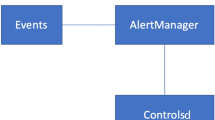Abstract
Software testing via environment simulation is an approach to testing safety critical software. By this approach, to test software in adverse conditions we need to simulate the failure processes of the environment system. Such testing is essential for safety critical software, especially for protection software. However, due to the complexity of failure processes, the development of simulators of failure processes is complicated, expensive and difficult. This paper presents a method to derive such simulators systematically and efficiently. The basic idea is to inject faults into the simulator of the healthy environment system to obtain the simulators of faulty environments.
The work reported here is funded by Nuclear Electric, plc., UK. and is a part of the CONTESSE project of DTI's Safety Critical Systems Programme.
Preview
Unable to display preview. Download preview PDF.
Similar content being viewed by others
References
Aho, A. V. & Peterson, T. G., A minimum distance error correcting parser for context free languages, SIAM J. Comput., 305–312, (Dec. 1972)
Burns, A., McDermid, J., & Dobson, J., On the Meaning of Safety and Security, The Computer Journal, Vol., 35, No.1, 3–15, (January 1992)
Budd, T. A, Mutation Analysis: Ideas, Examples, Problems and Prospects, In: Chandrasekaran, B., and Radicchi, S. (eds.): Computer Program Testing, North-Holland, 1981,pp.129–150.
Burstall, R. M., and Darlington, J., A transformation system for developing recursive programs, Journal of ACM, Vol. 24, No.1, (1977)
DeMillo, R. A., Guindi, D. S., McCracken, W. M., Offutt, A. J., King, K. N., An Extended Overview of the Mothra Software Testing Environment, In: Proceedings of Second Workshop on Software Testing, Verification, and Analysis, July 1988, pp142–151.
DeMillo, R. A., Lipton, R. J. A., & Sayward, F. G., Hints on Test Data Selection: Help for the Practising Programmer, Computer, Vol. 11, No.4, pp34–41. (1978)
Hall, P. A. V., and Weedon, R., Object oriented module interconnection languages, In: Prieto-Diaz, R. & Frankes, W.B., (eds.): Advances in Software Reuse, Selected papers from the second international workshop on software reusability, March 24–26, Lucca, Italy, IEEE Computer Society Press. (1993)
Hall, P. A. V. (ed.), Software Reuse and Reverse Engineering in Practice, Chapman & Hall. (1992)
Howden, W. E., Weak Mutation Testing and Completeness of Test Sets, IEEE Transactions on Software Engineering, Vol. SE-8, No.4, July, 1982, pp371–379.
Jin, L. & Zhu, H., A Metalanguage to Express Human Guidance for Program Transformation, In: Proceedings of IEEE International Workshop on Tools for Artificial Intelligence, IEEE Computer Society Press, Fairfax, USA, October 1989, pp717–722.
Jin, L., TrapML — A Metalanguage for Transformational Programming, Journal of Computer Science and Technology, (January 1991)
Jin, L., Zhu, H., and Xu, J., NDTPS — An Experimental Metalanguage Transformational Programming System, In: Proc. of Inter. Conf. on New Generation Computer Systems, Beijing, April 1989.
King, K. N., & Offutt, A. J., A Fortran Language System for Mutation-based Software Testing, Software — Practice and Experience, Vol. 21, No. 7, pp685–718, (July 1991)
Leveson, N. G. & Harvey, P. R., Analyzing Software Safety, IEEE Transactions on Software Engineering, September, 1983, pp569–579.
Leveson, N. G., Cha, S. S., & Shimeall, T. J., Safety Verification of Ada Programs Using Software Fault Trees, IEEE Software, July 1991, pp48–59.
Leveson, N. G., Software Safety: Why, What, and How, Computing Surveys, Vol. 18, No. 2, pp125–163. (June 1986,)
Leveson, N. G., Software Safety in Embedded computer systems, Communications of the ACM, february 1991, pp34–46.
MacFarlane, A. G. J., Dynamical System Models, George G. Harrap & Co. Ltd., (1970).
Fishwick, P. A. and Luker, P. A., (eds.), Qualitative Simulation, Modeling and Analysis, Advances in Simulation Vol. 5, Springer-Verlag, (1991)
Ministry of Defence, Defence Standard 00-56 (Interim), Issue 1, April 1991.
Morell, L. J., A Theory of Fault-Based Testing, IEEE Transactions on Software Engineering, Vol. 16, No. 8, pp844–857. (August, 1990)
Partsch, H. and Steinbruggen, R., Program transformation systems, ACM Computing Survey, Vol. 15, No.3, (1983)
Pepper, P. (ed), Program transformation and programming environments, Springer-Verlag, (1984)
Prieto-Diaz, R., and Neighbors, J. M., Module interconnection languages, The Journal of Systems and Software, Vol. 6, pp307–334, (November 1986)
Redmill, F. & Anderson, T., (eds), Safety-Critical Systems: Current Issues, Techniques and Standards, Chapman & Hall, (1993)
Redmill, F. & Anderson, T., (eds), Directions in Safety-Critical Systems, Proceedings of the Safety-Critical System Symposium, Bristol. (1993)
Tracz, W., Tutorial: Software Reuse: Emerging Technology, IEEE Computer Society Press, (1988)
Veseley, W. E., Goldberg, F. F., Roberts, N. H., & Haasl, D. F., Fault-Tree Handbook, Reg.0492, US Nuclear Regulatory Comm., Washington, D.C., January (1981)
Wichmann, B. A., (ed), Software in Safety-Related Systems, BCS Special Report, John Wiley & Sons, New York, (1992)
Zhu, H., Hall, P. A. V. and Cockram, T., Testing Protection Software Through Simulation of Failures, Technical Report, Dept. of Computing, The Open Univ.
Zhu, H., Hall, P. A. V, Testing Protection Software Through Simulation of Failures, Proc. of RTS'94, Jan. 11–14, 1994, Paris, pp155–170.
Zhu, H., Hall, P. A. V, May, J. H. R., and Cockram, T., Knowledge engineering helps testing protection software, Proc. of SEKE'6, June 20–23, 1994, Jurmala, Latvia, pp116–123.
Author information
Authors and Affiliations
Editor information
Rights and permissions
Copyright information
© 1994 Springer-Verlag Berlin Heidelberg
About this paper
Cite this paper
Zhu, H., Hall, P.A.V., May, J.H.R., Cockram, T. (1994). Injecting faults into environment simulators for testing safety critical software. In: Echtle, K., Hammer, D., Powell, D. (eds) Dependable Computing — EDCC-1. EDCC 1994. Lecture Notes in Computer Science, vol 852. Springer, Berlin, Heidelberg. https://doi.org/10.1007/3-540-58426-9_134
Download citation
DOI: https://doi.org/10.1007/3-540-58426-9_134
Published:
Publisher Name: Springer, Berlin, Heidelberg
Print ISBN: 978-3-540-58426-1
Online ISBN: 978-3-540-48785-2
eBook Packages: Springer Book Archive




